This was published 4 years ago
Kyushu: Japan's lesser-known southern island and base for 2019 Rugby World Cup games
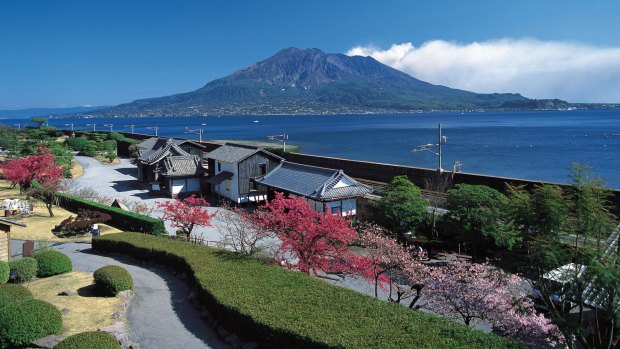
Sakurajima Volcano in Kagoshima.Credit: JNTO
Industrial Japan peels away as I fly south from Tokyo. The plane skims over Mount Fuji and past Hiroshima, and then the coast crinkles, the sea turns sub-tropical green and we're approaching Kyushu, Japan's southernmost main island. It's a verdant land, ragged-edged with bays and islands. Steam rises from hot springs and volcanoes smoulder.
Much has recently been made about Japan's soaring tourist numbers, with nearly 30 million international visitors arriving annually, including 400,000 Australians. But Japan is big, and most tourists are corralled into destinations such as Kyoto and Nara. Only Koreans seem to have discovered Kyushu, though that may change as rugby fans descend on three Kyushu cities – Fukuoka, Kunamoto and Oita – for World Cup matches.
As my plane descends into Oita, I wonder whether we're about to land in the ocean. The runway is built on reclaimed land, and the airport is tiny. Its only conveyor belt quickly coughs up my suitcase. I consult my handbook for details and am soon on a shuttle bus that skirts a rocky coastline before lurching into hills that frame emerald-green farmland. The road is lined with camellias and bamboo. Then it sneaks through tunnels around the bay at Beppu, and down into adjacent Oita.
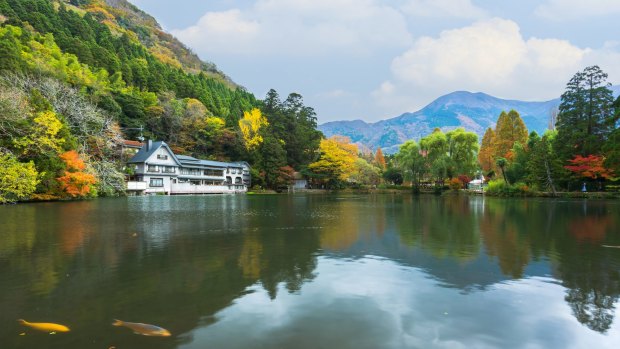
Yufuin, a popular ansen resort in Kyushu sits on Lake Kinrinko.Credit: iStock
Too easy. In Tokyo, I'd have spent 90 minutes on tangled freeways, and might have queued an hour to activate my Japan rail pass. In Oita, I find a sedate city easy to navigate, and agreeable country service at the train station. A uniformed staff member fills out my rail pass paperwork for me, and I'm done. I flick through my handbook again, and find a lunch recommendation nearby. A satisfying bowl of ramen noodles later, and I'm ready for anything.
My handbook is courtesy of Inside Japan Tours, which specialises in flexible, self-guided journeys. The company takes the trouble out of organising, booking and creating an itinerary, but I'm free to wander as my mood – and handbook – suggests. For the first-timer in Japan, it provides valuable insight and a safety net without crushing your spirit in a group tour.
I've been to Japan many times, but only briefly to Kyushu. I'm cutting across the island from Oita on a pre-rugby recce to other World Cup venues Kunamoto and Fukuoka, but will discover far more than just stadiums. I'll find Kyushu a low-key destination well worth exploring, easily navigated, rich in scenery and culture, yet largely undiscovered by Western tourists.
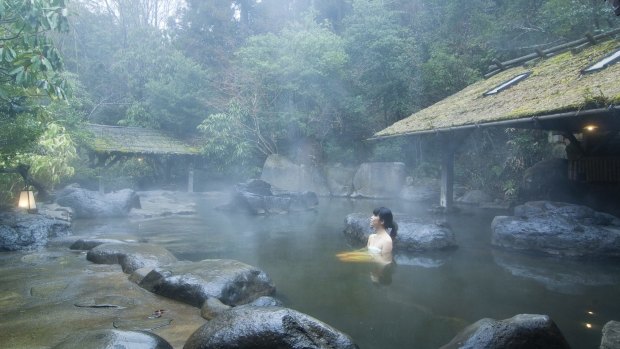
A hot-spring bath in Kurosawa Onsen.Credit: Kyushu Tourism
Oita Stadium will be the venue for Australia's early round match against Uruguay in the Rugby World Cup on October 5. The stadium, named for the prefecture rather than the town, is actually in adjacent Beppu, training base for the Australian and New Zealand rugby teams. With 40,000 fans expected, the small city, already known in Japan for its raucous entertainment, will be going off.
Beppu is the biggest onsen (hot-spring resort) in Japan, now somewhat old-fashioned but still a favourite among Japanese for its scores of bathhouses and startling "hells" of boiling orange or electric-blue water. I wend my way around historic Kannawa district from temple to old cafe to hot spring, before cooking a lunch of vegetables and beef over a steaming fumarole. Then I head down to the bay, where I'm buried up to my neck in volcano-warmed black sand, leaving me surprisingly invigorated for a night out. Beppu's back streets have seemingly endless neighbourhood restaurants serving sushi, yakatori (skewered chicken) or ramen noodles. Afterwards there are bars and karaoke lounges with welcoming rugby banners already hung in their windows, and locals eager to test the Australian capacity for shots of shochu.
Next day, I gingerly head inland. I pause for a few hours at Yufuin, which sits in the hills just inland from Beppu around gently steaming Kinrin-ko Lake. Then it's onwards to Kurokawa, one of Japan's most attractive hot-spring resorts, with a well-preserved centre of wooden riverside buildings deep in a forest-draped valley.
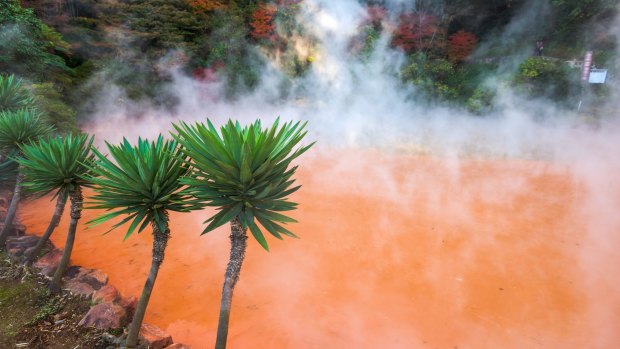
The Blood "Hell" Hot Spring, Beppu, Japan.Credit: iStock
Not much further is Kyushu's most stunning sight, the vast caldera of Mount Aso. The crater is 128 kilometres in circumference – enough to hold farmland and several towns – and ringed by five volcanoes, including the very active Naka-dake, whose boiling crater lake spews steam and reeking gas.
This region is geologically active. In 2016 an earthquake heavily damaged Kumamoto Castle, which I find still closed, although parts are due to reopen for the Rugby World Cup, when France, Wales, Uruguay and Tonga play matches here in October. Still, the castle is impressive even from outside, especially when it is illuminated at night. This is Japan's largest and most complete castle and held out until 1877 as the country's last samurai stronghold.
On the way north to Fukuoka, I stop at Dazaifu for another dose of history. The Kyushu National Museum has a terrific exhibition of pan-Asian artefacts that show the interrelations between its cultures created by religion, trade and social influences. As an added bonus, it sits beside Dazaifu Tenmangu, one of Kyushu's most important Shinto shrines. Locals come here to pray for success in study and exams, providing the venerable thousand-year-old grounds with a youthful, busy vibe.
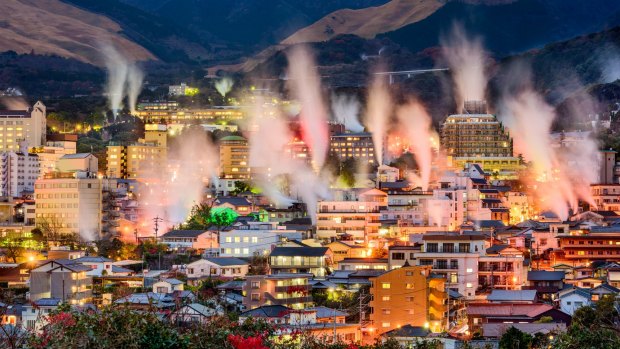
Hot spring bath houses with rising steam in Beppu, Japan.Credit: iStock
My journey finishes in Fukuoka. I'm fortunate here to have a day with Ben Walker, one of Inside Japan Tours' tour leaders. The Aussie expat has a Japanese wife and has lived in Japan for nearly two decades. He's also a rugby tragic thrilled that Fukuoka is hosting three early World Cup matches. He played rugby at university, and his son plays for a local team. Ben's enthusiasm for his adopted city is evident and heart-warming. He takes me around the lakeshore in Ohori Park, to Japan's first Zen temple, then out for an evening in the entertainment district. It's a great chance to see Fukuoka from an insider's perspective and to plunder Ben's mind about the quirks of Japanese society and the pleasures and challenges of expat life.
We finish at an izakaya, Japan's hybrid between pub and tapas bar. We tuck into a Fukuoka-style potato salad, a pot of cockles and skewered chicken sizzled over charcoals. I'm the only tourist in this neighbourhood izakaya. In the whole of Kyushu during this blue-sky winter I've scarcely seen a Westerner, yet found another lovely corner of Japan filled with unexpected pleasures.
FIVE MORE KYUSHU DESTINATIONS
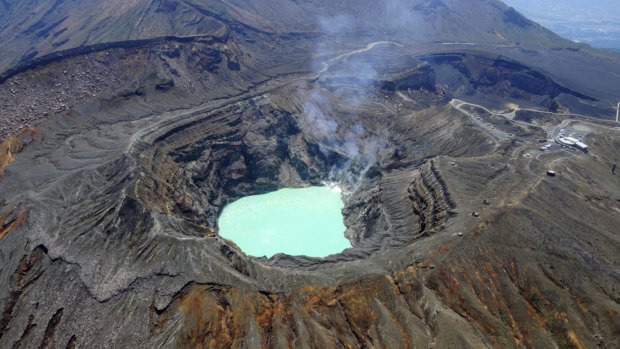
Volcanic crater at Mt Aso.Credit: Kyushu Tourism
NAGASAKI
This port city, forever associated with World War II, has a long history of trade. Visit the disturbing Atomic Bomb Museum and also learn about Nagasaki's bustling Chinatown and Dutch port settlement. A visit to hills dotted with European villas provides a fascinating cultural clash. See visit-nagasaki.com
KAGOSHIMA
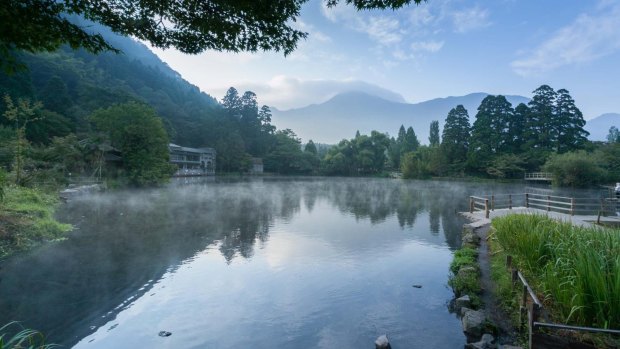
Kinrin-ko Lake in Yufuin.Credit: Kyushu Tourism
Kyushu's most southern city is compared to Naples thanks to its generous bay, balmy weather and active volcano, Sakurajima, best admired from Shiroyama Hill or Sengan-en Garden which surrounds a samurai villa. A ferry brings you to the volcano's base. The relaxed, easy-going city has great eateries. See kagoshima-kankou.com
YANAGAWA
This town halfway between Kunamoto and Fukuoka is built across 16th-century canals used for trade and defence. The castle has gone, but the town has samurai residences, temples, old warehouses and fine villas. Take to a punt for relaxing sightseeing, then lunch on grilled eel. See yanagawa-net.com
UNZEN
Japan's first national park features still-active stratovolcanoes. Nita-toge Pass at the summit of a cable car gazes over the amazing landscape of sulphur-smelling cauldrons, steam vents and bubbling mud. Unzen town has hot-spring resorts. Spring features pink azaleas, autumn spectacular maple trees. See unzen.org
YAKUSHIMA
This mountainous, rainy island has a subtropical climate and is notable for its World Heritage cedar forests, where many trees are more than a millennium old. It also has significant wildlife, including monkeys and deer, and is a nesting site for loggerhead turtles. See kagoshima-kankou.com
TRIP NOTES
Brian Johnston travelled as a guest of Japan Airlines, Inside Japan Tours and Kyushu Tourism.
MORE
FLY
Japan Airlines flies daily from Melbourne and Sydney to Tokyo Narita with onward flights to Fukuoka and other cities in Kyushu. See jal.co.jp
TOUR
Inside Japan Tours organises self-guided adventures in Kyushu based on interests, budget and destination. It provides details, booking assistance, back-up support and occasional day tours, but you explore on your own.See insidejapantours.com
RUGBY
The Rugby World Cup runs until November 2, with matches held at 12 venues across Japan. See rugbyworldcup.com
Sign up for the Traveller Deals newsletter
Get exclusive travel deals delivered straight to your inbox. Sign up now.